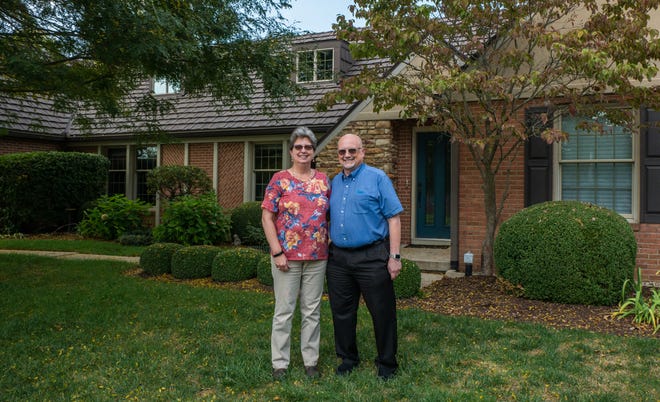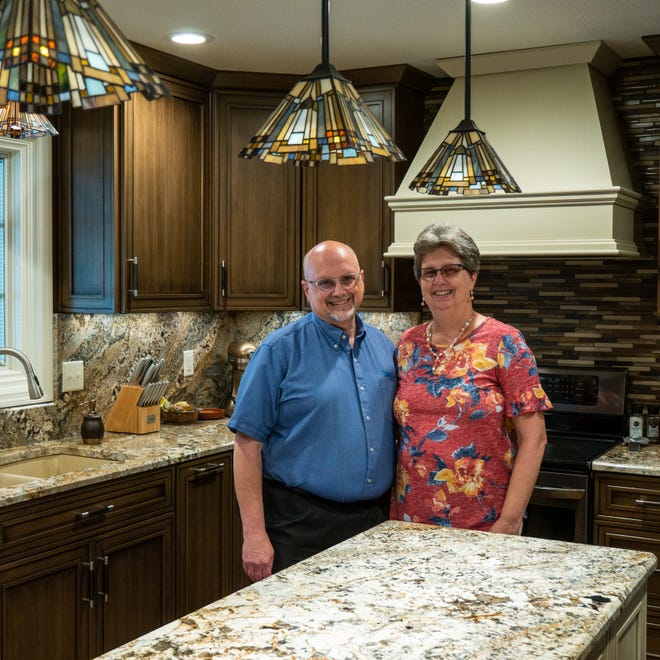Tanisha A. Sykes

For Todd and Lisa Miller, making major improvements to their 3,100-square-foot rambling ranch, built in the 1970s, is par for the course.
“Over the years, we have refinanced twice and done a number of improvements,” says Todd, president and co-owner of Isaiah Industries Inc., a manufacturer of permanent roofing solutions.
They also live frugally, so they saved and took some cash withdrawals from whole life insurance policies.
The Millers bought their “forever home” in Sidney, Ohio, in the 90s, and have completed several renovations, including a $125,000 master ensuite addition, a family room expansion, new stucco on the home’s exterior, and new windows. The couple, who live on a street full of custom homes, also added a $95,000 in-ground swimming pool and landscaping. Plus they remodeled an office, bathroom, and utility room for $45,000.
Housing buying tips:It’s a tough market. Here’s how buyers are doing it.
Projects that won’t bust your budget:Small, manageable projects to make home more welcoming

The Millers have spent $712,000, not including other investments, upgrades, and repairs along the way. The home has nearly doubled in value, says Todd, yet it is currently worth around $360,000 because they don’t live in an area with exceptionally high real estate values. “We’re horribly upside down, but we don’t regret anything,” he says. “All of the investment has been to make our home what we want it to be.”
Most experts advise against going overboard on home improvements.
“The money spent on a renovation may not always run congruent with the value a buyer places on the ‘upgrade’ or ‘update,’” advises Omar A. Barragán , a New York real estate salesperson with Corcoran Baer & McIntosh. “You can spend $10,000 making your kid’s room look like an amusement park from the Paleolithic era, but unless a prospective buyer has that specific need, you may not see the money come back to you upon selling.”
Earlier this year, Zonda Media released its 2021 Cost vs. Value Report, citing the trend of exterior improvement projects providing the greatest return on investment (ROI ). With the exception of a minor kitchen remodel, fixes on the outside of a home represent 11 of the 12 leading investments. Notably, siding, stone veneer, and garage door replacements top the list.
Preparing to buy:How much money should you have to buy your first home?
Whether you’ve recently closed on your home, are planning to sell, or intend to stay for the long haul, here are some improvements that yield high returns on your investment.
1. Boost curb appeal
The fate of many homes for sale is decided on the walk from the car to the front door. Take the time, and money, to make the exterior inviting.
“Improve your landscaping with bright flowers, a variety of shrubs, and clean walkways,” says Fiona Dogan, a realtor with Julia B. Fee Sotheby’s International Realty in New York. If you don’t, buyers will cruise on by the property.
Lush greenery, a healthy lawn, and the right mix of flower beds recover an estimated 267% of the cost of upkeep at the time of the sale, according to a HomeLight survey.
2. Replace garage doors
When homeowners are looking for projects that pay off, experts say new garage doors top their list.
“A $500 new door could add $5,000 to your selling price in the right neighborhood,” says Michele Harrington, First Team Real Estate’s chief operating officer in California.
Barragán of Corcoran Baer & McIntosh agrees: “I have seen clients balk at a house with a dilapidated garage door,” he says. A garage door replacement returns 93.8% of its value, according to the Cost vs. Value report.
3. Upgrade the kitchen
This is the hub of the house where families cook, eat, gather, and socialize. Consider professional-grade efficient appliances, multiple seating options, and marble or quartz countertops, Dogan says. “A renovated kitchen can add up to $100,000 to the value of a home,” for higher-end projects, she says. Owners can expect to recoup 72.2% of their investment for a minor kitchen remodel, according to the Cost vs. Value report.
4. Replace siding
One way to keep your home warmer in the winter and cooler in the summers is to add new siding.
“The exterior of your home is important to keep hot air from coming in during the summer and cold and rain coming in during the winter,” says John Bodrozic, co-founder of HomeZada, a personal finance platform in California that helps owners to better manage the financial details of their homes.
“Replacing siding also lowers energy costs, which has a huge impact on the home’s value if you decide to sell.” The report shows both fiber cement, 69.4%, and vinyl siding, 68.3%, retain much of their value.
5. Remodel the bathroom
Renovations of any kind are daunting, especially when it comes to bathrooms, a sanctuary of the house that should include form, function, and touches of luxury.
“Consider white tile, chrome or nickel fixtures, a white porcelain shower and tub, and efficient low-flow toilets and new piping,” says Dogan. “A renovated bathroom can add up to $50,000 to the value of your home,” for a dream renovation with top-of-the-line additions. An upscale bath remodel can net homeowners 54.8% of the project price when selling, the report notes.
Making necessary improvements to a home pays off in the end.
Despite technically being “upside down”, the Millers say they have always saved as much as possible for retirement and have a good bit of equity in their home.
“We took advantage of a neighborhood we find very inviting and have created a lifestyle we love,” says Todd.
It communicates to prospective buyers that the home is cared for.
“Think of adding value to your home as a savings account,” says Barragán. “The more you improve something, the more likely you’ll retain your investment, and hopefully, even profit from it.”





More Stories
Townhouse or Condo – What Is the Difference?
Getting Financed For The Condo You Want
How To Tell If You Have Swarmer Termites and What To Do About It